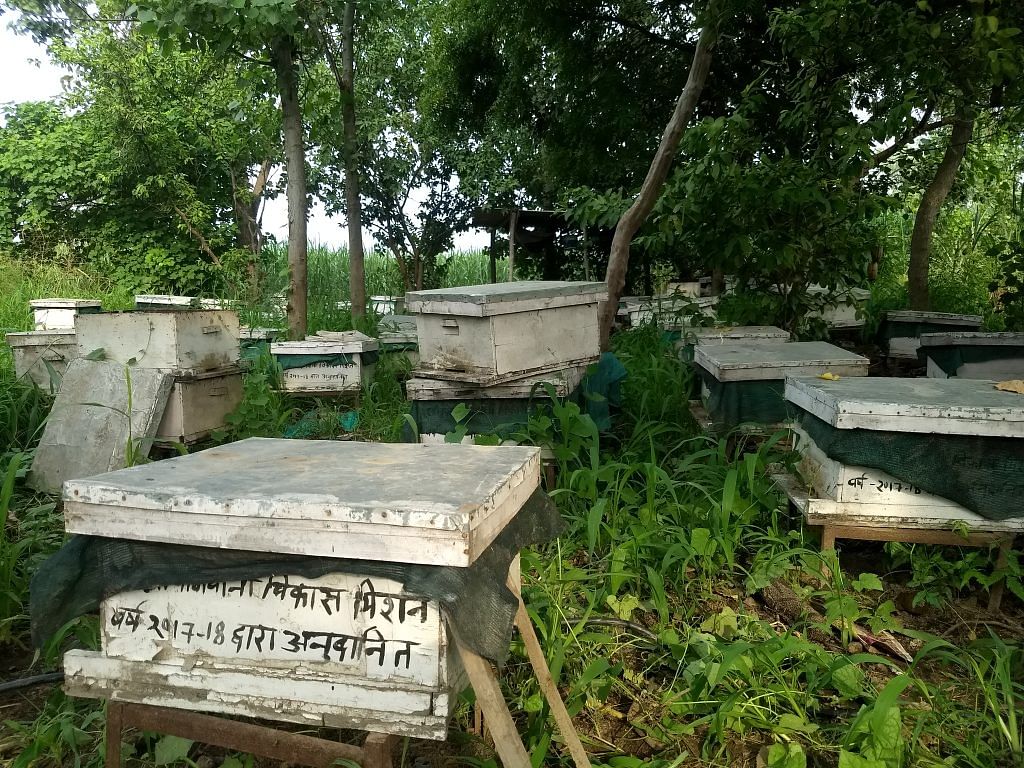The number of honey bee colonies have gone up from 20 lakh to 30 lakh between 2014 and 2016, while exports have increased nearly ten-fold.
New Delhi: Wearing his dirty white bee veil, Devinder Kumar bends down to open a bee box. With a hoe, he carefully extracts a rectangular wooden frame, on which the bee swarm has carefully built a mosaic of minute hexagonal wax cells.
“This is the honeycomb, which the bee uses to store not only honey, but pollen and eggs as well,” Kumar tells ThePrint.
“I started keeping bees 20 years ago, as an extra source of income, instead of travelling to the city in search of jobs in the off-season from sugarcane farming. Two years ago, my profit was Rs 2 lakh. I now own a tractor and three motorcycles.”

Standing on his lush green two-acre farm in Rewari village in Ghaziabad district of Uttar Pradesh, 60-year-old Kumar is a contented man. He no longer works on sugarcane and has shifted completely to organic farming and bee-keeping.
Picking up steam
Devinder Kumar is an early mover in an industry that has picked up steam in less than a decade. According to a 2017 report by the Khadi and Village Industries Commission (KVIC), there are as many as 2.5 lakh beekeepers and wild honey collectors in India today, producing 70,000 tonnes of honey worth Rs 770 crore annually.
Also read: This is how GM crop Golden Rice could solve Vitamin-A deficiency in Asia
The number of honey bee colonies — consisting of a queen, hundreds of male drones and thousands of female worker bees — have gone up from 20 lakh to 30 lakh just in the space of two years, from 2014 to 2016.
Simultaneously, exports have almost doubled. In 2006-07, exports amounted to 8,135.6 tonnes and were worth nearly Rs 61 crore. By 2017-18, according to the Agricultural & Processed Food Products Export Development Authority (APEDA), India had exported 51,547.31 tonnes, worth an additional Rs 653.58 crore.
At a time of widespread rural distress, officials say they believe that with a little extra money and effort the results from bee-keeping can become a money-spinner.
The National Bee Board, established under the ministry of agriculture & farmers’ welfare, is expected to work with NGOs who run awareness and training programmes across the country. The government allocated Rs 50 crore in 2017 to promote bee-keeping and honey production.
Also read: Scientists get glimpse of life 3.4 billion years ago. It’s likely the oldest we have yet
Manoj Sharma, who runs an NGO in Dhaulana village in Hapur district of Uttar Pradesh, says he has carried out one such awareness and training programme in six districts of Madhya Pradesh, where for seven days batches of 25 farmers were introduced to the practical and theoretical secrets of bee-keeping.
Extracting honey
Sharma explained to ThePrint the very delicate process by which honey is extracted.
“Once the bee box is opened, one rectangular frame is removed at a time. If you look carefully, you will see the bees have dropped a thin layer of wax to cover the small cells of the honeycomb. This is called honey capping. Under this is the dried honey. With a stainless steel knife, we remove this thin layer in a gentle sideways motion.

“After all the frames are uncapped, we put them inside a mechanical device called honey extractor. This is a cylindrical container comprising a frame basket which rotates on applying centrifugal force, thereby extracting honey from the honeycombs. Then through a strainer, the honey is filtered and poured into the bottles,” Sharma said.
Fragile state
But the nascent beekeeping industry, despite its enormous potential, is also in a fragile state. First, it is hugely dependent on the international market. Second, domestic conditions have been uneven these last two years, due to demonetisation. Third, the excessive use of insecticides kills bees. And fourth, the multiplicity of agencies in government adds to the confusion as to who is really in charge.
The alphabet soup of abbreviations has hardly helped the industry.
For example, APEDA comes under the ministry of commerce & industry, KVIC comes under the ministry of micro, small & medium enterprises, while RKYY (Rashtriya Krishi Vikas Yojana), MIDH (Mission for Integrated Development of Horticulture) as well as the National Bee Board come under the ministry of agriculture & farmer’s welfare.
Kumar also pointed out that the big honey manufacturers somehow end up controlling the market, thereby also driving the price down. Despite assistance from the various government agencies, he said, the price of honey as well as other honey products like pollen and propolis (a darkish substance used in the treatment of infection and bee bites) has fallen.
But B.L. Sarswat, executive director of the National Bee Board, defended against the charge, saying the price of honey heavily depends on its export. “We cannot do much about the fall in the international price of honey. The government understands the plight of farmers and is trying to solve the issue,” he told ThePrint.
Still, Kumar is optimistic. Since he started bee-keeping, he said, the cross-pollination of his crops not only means that he doesn’t need to spend as much money on pesticides to boost production, but that crop yields have gone up by as much as 20 per cent.
He cites the Ramayana: “When Ramchandraji asked his followers to build a bridge over the sea to reach Lanka, squirrels, along with thousands of monkeys, lifted the stones. My bees are like those squirrels.”



